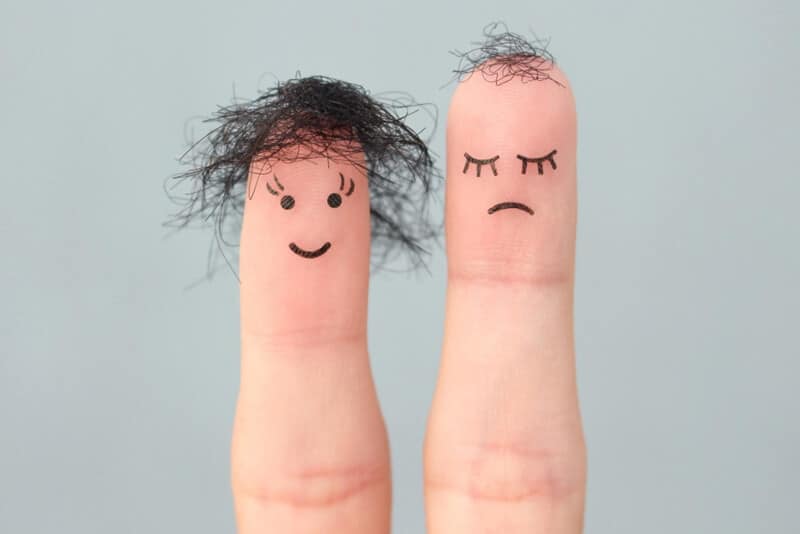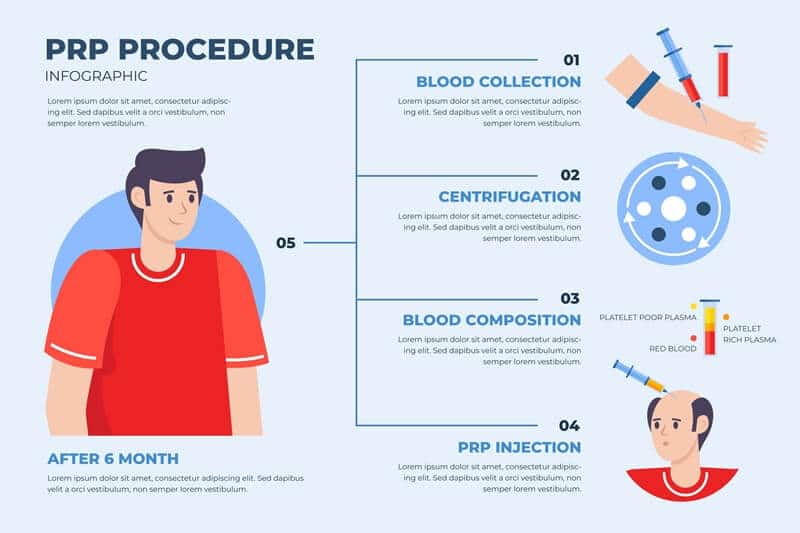Almost everyone likes to style their hair and have a unique hairstyle. However, no one predicts that there may be big problems due to only styling. Traction alopecia is one of them and causes hair loss. This problem occurs due to the continuous pulling force applied to the hair. As it develops over time, most of the time it is not noticed at the beginning. So, when is it too late when traction alopecia is noticed? How can you understand what stage you are at? Treatment methods and all the details are in our article.
Table of Contents
What is Traction Alopecia?
Traction alopecia is a type of hair loss that can be seen due to preference of braids, hair rollers, and African-style hairstyles and the use of loosening chemicals for straightening them. It is a problem that affects approximately 65% of women of African origin.
Traction alopecia is a problem that occurs due to the prolonged and repetitive pulling force on the scalp. The duration of pulling and how severe it is directly affects the size of the problem. Also, processed hair is at greater risk in case of such pulling. If the pulling on the scalp continues, scars that are difficult to heal may occur in the following stages. That is why the question of when it is too late for traction alopecia is very important.
Traction Alopecia Stages
Traction alopecia has different stages in itself. Since it is a problem that develops over time, different situations may occur in the process of the problem.

-
Early-Stage Traction Alopecia
Early-stage traction alopecia causes the hair follicles affected by the pulling force to pass into the telogen phase. Besides, localized traumas in the hair follicles can also be seen. Such a situation may occur due to the forced pulling of the hair strands. Hair follicles that pass into the telogen stage cannot produce hair strands and thus the hair follicle cannot grow.
-
Late Stage Traction Alopecia
Late-stage traction alopecia may cause scarring in the related areas. This situation arises due to the lack of diagnosis. The aim of the treatment applied after the formation of scarring is to reduce the tension on the scalp.
Early diagnosis is important here and may help the treatment process. However, sometimes the treatment process can be extremely troublesome. According to some doctors, late-stage traction alopecia may be an irreversible situation. The answer to the question of when it is too late for traction alopecia is hidden in these details. Therefore, early diagnosis is very important.
Read Also: Scalp Psoriasis Hair Loss: Here’s What to Do!
Signs of Traction Alopecia
Traction alopecia, an unusual type of hair loss, has several symptoms that will make the causes of the problem apparent. Common symptoms of traction alopecia are as follows:
- Multiple hair-splitting
- Thinning of hair
- Itching on the scalp
- Bald patches
- Redness or inflammation on the scalp
- Significant hair loss in the anterior and crown areas
- Sweating on the scalp
- Red swellings on the scalp
How are the First Symptoms Noticed?
The symptoms of traction alopecia may sometimes be unnoticed. As it progresses very slowly, it is often difficult to see the loss. It first manifests itself in the form of thinning in the front hairline and around the ears.

You should closely monitor the changes in the strength, thickness, and texture of your hair. The symptoms of traction alopecia are not always noticeable. However, over time, more apparent symptoms may begin to appear. Pustules that look like white dots appear on the scalp together with small rashes and swellings.
Traction Alopecia Causes
Traction alopecia is a condition that may cause significant problems in the hair and scalp. Different situations cause or predispose to the emergence of this disorder. Major ones can be listed as follows:
- Preferring tight ponytails, braids, and similar styles that exert a pulling force on the scalp.
- Long-term use of narrow caps and helmets
- Long and frequent use of accessories such as hairpins, hair bands, and hair rollers
- Long-term use of hairstyles with long and heavy curls
- Frequent pulling of hair strands due to compulsive disorder
- Hair and beard twisting habits
When we look at the above reasons, it is seen that almost all of them are up to the person. Therefore, if you do not want to ask the question of when it is too late for traction alopecia, you should pay attention to these points and avoid these actions.
Read Also: Does Syphilis Cause Hair Loss? | Symptoms & Treatments
Who Are Under Risk?
This problem can occur in men or women of all races. However, it is known that women of African origin are more prone to the related problem and it is more commonly seen. Epidemiological studies show that the basis of the problem is that African women frequently prefer hairstyles such as dreadlocks and braids.

Another country where this problem is seen intensely is India. Men and women here gather their hair in tight knots under the turban. Because of this situation, the proportion of seeing traction alopecia is also high in this country. Also, gymnasts, Caucasian ballerinas, and soldiers are prone to this problem.
How Do You Know It is Too Late for Traction Alopecia?
Many symptoms of traction alopecia will answer the question of when it is too late. When you notice these, you need to consider them as a warning sign and take the necessary steps regarding the treatment process. These symptoms are:
- Scalp redness
- Headache due to the preferred hairstyle
- Sensitivity, flaking, and itching on the scalp
- Regression due to hair loss in the front and side hairlines
- Scalp sensitivity after hair loosening
- Long-term inflammation of the scalp (folliculitis)
- Small skin-colored rashes or white bumps around hair follicles
Read Also: Can My Hair Grow Back After Hair Loss?
How to Stop Traction Alopecia?
When you notice symptoms that signal the answer to the question of when it is too late for traction alopecia, you should take some steps to avoid further damage to your scalp. Thanks to these steps, the problem will not grow anymore and the treatment of traction alopecia will be easier and give more effective results. Here’s what you need to do at this point:

- Leave your hair free instead of gathering at the top.
- Do not prefer tight and twisted bun models.
- Change your hair styling habits. Go for low to medium-risk hairstyles such as loose braids and loose ponytails.
- Do not use heat rollers and similar accessories that will put pressure on the hair follicles.
- Avoid combing your hair when it is wet.
- Do not use tight elastic rubber ties and bands.
- Use wigs made of skin-friendly materials such as satin and cotton to prevent scalp friction.
- Do not use heat-based appliances such as hairdryers, hair straighteners, and hair tongs. When you need to use them, make sure you use them carefully.
- Use satin and silk pillowcases. Thus, you reduce friction.
Read Also: Can Patients with Alopecia Areata Have Hair Transplantation?
Traction Alopecia Treatment Options
If this problem is not treated, it can cause permanent hair loss. Those who understand that they have traction alopecia with the question of “When is it too late?” should start the treatment process immediately. There are different treatments applied. The details of these are as follows:
-
Biotin Supplements
They are prescribed for the treatment of folliculitis that occurs due to traction alopecia. Oral antibiotics may also be prescribed by the dermatologist in addition to biotin supplements. Thus, damaged follicles will enter the healing process.
-
Antibiotics
They are prescribed for mild to moderate traction alopecia and give effective results in the prevention of infection. Depending on the answer to the question of “When is it too late for traction alopecia?” you can overcome the problem with antibiotic treatment to a great extent.
-
Steroids
Depending on the type and form of hair loss, intralesional or topical steroid treatment may be recommended by the dermatologist. Steroids are injected directly into the scalp to strengthen the hair follicles. Besides, they contribute to the treatment of inflammation and redness of the scalp. Moreover, some steroids can directly affect hair growth positively.
-
Medications
Tablets, pills, creams, and medicated shampoos may be prescribed by dermatologists for the treatment of traction alopecia. Spironolactone and Finasreid are the most preferred medications for reducing hair loss. Apart from these, medicated shampoos can give effective results in reducing inflammation and infection in the scalp.
-
Laser Treatment
Laser treatment is applied to reactivate hair follicles. The laser used for the treatment of hair loss has given effective results and has become a solution for this problem. The light beam defined at a certain frequency is applied to the relevant part of the scalp. Thus, blood flow and circulation in that area are improved.
-
PRP Treatment

Platelet Rich Plasma treatment is the use of enriched platelets obtained from the patient’s blood to regrow hair. Enriched platelets are injected directly into the scalp. Active plasma is quite rich in terms of growth factors. Thanks to this situation, it enables the dormant hair follicles to be activated and to produce hair again.
-
Topical Treatments
Minoxidil is the only FDA-approved topical treatment dermatologists use for traction alopecia. This easily available medication is in foam or solution form. Concentrated at a rate of 2% to 5%, it is applied directly to the scalp. This medication must only be used with dermatologist approval. Besides, it has to be only applied to the bald area to be treated. Otherwise, it may cause hair growth on cheeks and similar areas. For more detailed information, you can review our guide on Minoxidil for beginners.
-
Hair Transplantation

When the damage to the hair follicles is permanent and irreversible, the only method to be preferred is hair transplantation. Following the question of when it is too late for traction alopecia, when other treatment methods fail or when it is understood that the hair follicles are permanently lost, hair transplantation should be preferred. Hair transplantation is also the most effective form of treatment that gives permanent and definite results.
Read Also: Why Is Turkey the Best Place to Have a Hair Transplant?
How Long Does it Take for Hair to Regrow after Traction Alopecia Treatment?
The regrowth time for hair loss due to traction alopecia varies depending on how big the problem is. This is why the question of when it is too late for traction alopecia is important.
If the problem is detected early and the treatment is applied successfully, the hair will start to grow back in about 6 months. In severe cases, it may take a year or a little longer for hair to regrow. In badly traumatized cases, the chance of hair regrowth is lower due to scar tissue.
CONCLUSION
This problem, which occurs due to the pulling force on the scalp, can cause permanent hair loss. With timely and right treatments, the problem can be overcome.

For the treatments related to the answer to the question of when it is too late for traction alopecia, choosing the right clinic is important. Cosmeticium has great experience in hair transplantation and other treatments used for traction alopecia. With the treatment to be applied, you can have your hair and old appearance back. You can contact us for detailed information on the subject.
Fill In The Form Below To Get Answers To All Your Questions About Hair Loss & Alopecia From Our Doctors Within Hours. (FREE)

